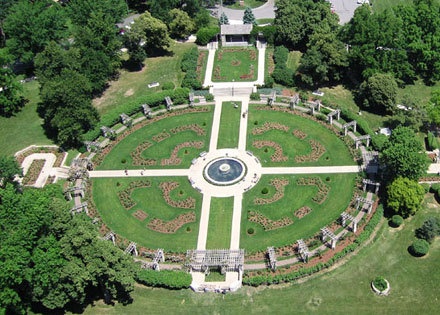
| Kansas City's Rose Garden
A brief history of the Laura Conyers
Sarajane S. Aber
With aerial photographs by J.S. Aber
|
| Introduction | Origin in 1930s |
| Later development | 75th anniversary |
| 2010 update | Reference |

| Kansas City's Rose Garden
A brief history of the Laura Conyers
Sarajane S. Aber
With aerial photographs by J.S. Aber
|
| Introduction | Origin in 1930s |
| Later development | 75th anniversary |
| 2010 update | Reference |
How this civic treasure came to be and continues to flourish is a real mid-American success story, which features the enabling spirit of volunteers with a worthy cause. Kansas City's rose garden today is the realization of a dream that began in 1931, when a group of public spirited citizens under the imaginative and enthusiastic leadership of Laura Conyers Smith established the Kansas City Rose Society and the public rose garden in Loose Park. It is also the story of a harmonious partnership with Kansas City's Park Department (Parks & Recreation Department since 1967), which has served well from the beginning.
On April 30th, when the radio presentation was to be "How to establish a municipal rose garden," 65 guests, including representatives of the Park Department, Chamber of Commerce, and area nurserymen, were treated to lunch and the radio show. With this introduction, Mrs. Smith proposed that Kansas City should have its own municipal rose garden. This project was so well showcased that the following week, on May 9, 1931, a branch of the American Rose Society was founded, the Kansas City Rose Society (KCRS), and Mrs. Clifford B. Smith was its first president.
In short order, representatives of the KCRS met with Park Department officials, and they agreed to establish a Municipal Rose Garden. This, then, was the beginning of the mutually beneficial partnership. KCRS would furnish the roses and the Park Department would care for them. On Sunday, June 7, 1931, following an elaborate rose show at the Smith's Westover Road home, the first unit of the garden, 120 rose bushes, was dedicated in the northwestern corner of Jacob L. Loose Memorial Park.
Origin in the 1930s
In the early 1930s there was nationwide enthusiasm for growing roses, especially much promoted hydrid tea roses, as well as for developing municipal rose gardens. Then, too, these were stressful years of the Great Depression and thoughts of gardens, roses and natural beauty were heartening. Laura Smith had come to Kansas City from the "City of Roses," Portland, Oregon, and was eager to share her personal rose growing knowledge and appreciation. Her very feminine technique for spreading rose zeal was to invite a few friends to her home for a cup of tea and to listen to weekly radio "Rose Talks," sponsored by the American Rose Society and aired in the spring of 1931. Mrs. Smith was obviously a natural and gracious promoter.
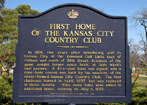
Right: statue of Jacob L. Loose given by his wife.
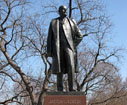
Through the years, pageantry has enlivened the garden with the music, dance and ceremony of annual Rose Day celebrations, idyllic Kansas City Ballet performances, and Rose Garden weddings. The KCRS also conducts educational demonstrations, workshops, and Garden Walks, all free to the public. Plans are currently underway to renovate and enhance the west terrace portion of the garden in the near future. The Laura Conyers Smith Municipal Rose Garden has given a bounty of beauty and pleasure--a treasure and gift for 75 years--and a promise for the future.
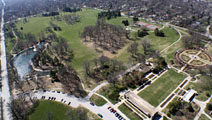
| Left: superwide-angle shot acquired March 18, 2010 with a helium blimp. The rose garden appears on the far right side. Right: airphoto of the Kansas City Country Club from 1927. Photograph © Wilborn & Associates; reproduced here by permission of Chris Wilborn (email: wilbornphoto@earthlink.net). Both views looking toward the southwest with Wornall Road on the left side. | 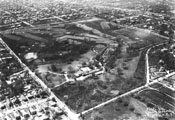
|
Our historical reenactment was taken at about the same time of day (late morning) and year (earliest spring), judging by shadows and status of vegetation. Our vantage point over the northeastern corner of the park was limited to 500 feet (150 m) height; the 1927 airphoto was acquired from higher and farther to the northeast. Compare these views with the original Loose Park design, shown above.
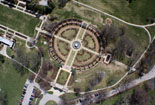
| Vertical shots over the rose garden. Left: overview of rose garden and surroundings; north toward side with parked cars. Right: closeup shot of the central rose garden. Rose beds appear clearly; the fountain at center is dry and covered with a tent. Compare these views with the original rose garden design, shown above. | 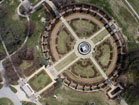
|
Return to GeoSpectra homepage.